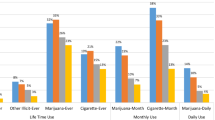Abstract
The purpose of the present study was to examine the hypothesis that religious affiliation, attendance at religious services, and religious importance would be negatively associated with substance use and sexual behavior related to substance use. An additional hypothesis was tested to determine if age-related differences in the magnitude of these associations was present. Data from the National Survey of Family Growth were utilized to examine these hypotheses in 12,571 women and men. Results showed expected associations between religiousness and substance use and sexual behavior. No age differences in the magnitude of these associations were identified. Religiousness may offer protection from health risks, and faith-based public health efforts would do well to continue to develop education for both young and middle age individuals that incorporate key aspects of their faith and religious beliefs.
Similar content being viewed by others
References
Cook, C. C. H. (2004). Addiction and spirituality. Addiction, 99, 539–551. doi:10.1111/j.1360-0443.2004.00715.x.
Fetzer Institute, National Institute on Aging Working Group (2003). Multidimensional measurement of religiousness, spirituality for use in health research. A report of a national working group. Kalamazoo, MI.
Geppert, C., Bogenschutz, M. P., & Miller, W. R. (2007). Development of a bibliography on religion, spirituality and addictions. Drug and Alcohol Review, 26, 389–395. doi:10.1080/09595230701373826.
Gillum, R. F. (2005). Frequency of attendance at religious services and cigarette smoking in American women and men: the third national health and nutrition examination survey. Prev Med An Int J Devoted Pract Theory, 41, 607–613.
Gillum, R. F., & Dupree, N. (2007). Religiousness, health, and health behavior in public-use data of the national center for health statistics. Journal of Religion and Health, 46, 155–165. doi:10.1007/s10943-006-9083-0.
Gorsuch, R. L., & McFarland, S. G. (1972). Single vs. multiple-item scales for measuring religious values. Journal for the Scientific Study of Religion, 11, 53–64.
Hackney, C. H., & Sanders, G. S. (2003). Religiosity and mental health: a meta-analysis of recent studies. Journal for the Scientific Study of Religion, 42, 43–55. doi:10.1111/1468-5906.t01-1-00160.
Hill, P. C., & Pargament, K. I. (2003). Advances in the conceptualization and measurement of religion and spirituality: Implications for physical and mental health research. American Psychologist, 58, 64–74. doi:10.1037/0003-066X.58.1.64.
Hill, P. C., & Hood, R. W. (1999). Measures of religiosity. Birmingham, AL: Religious Education.
Idler, E. L., Musick, M. A., Ellison, C. G., George, L. K., Krause, N., Ory, M. G., et al. (2003). Measuring multiple dimensions of religion and spirituality for health research: conceptual background and findings from the 1998 General Social Survey. Research on Aging, 25, 327–365. doi:10.1177/0164027503025004001.
Kendler, K. S., Liu, X.-Q., Gardner, C. O., McCullough, M. E., Larson, D., & Prescott, C. A. (2003). Dimensions of religiosity and their relationship to lifetime psychiatric and substance use disorders. American Journal of Psychiatry, 160, 496–503. doi:10.1176/appi.ajp.160.3.496.
Koenig, H. G., McCullough, M. E., & Larson, D. B. (2001). Handbook of religion and health. Oxford University Press.
Krause, N. (1991). Stress, religiosity, and abstinence from alcohol. Psychology & Aging, 6, 134–144.
McIntosh, W. M. A., Fitch, S. D., Wilson, J. B., & Nyberg, K. L. (1981). The effects of mainstream religious social controls on adolescent drug use in rural areas. Review of Religious Research, 23, 54–75. doi:10.2307/3511587.
Merline, A. C., O'Malley, P. M., Schulenberg, J. E., Bachman, J. G., & Johnston, L. D. (2004). Substance use among adults 35 years of age: prevalence, adulthood predictors, and impact of adolescent substance use. American Journal of Public Health, 94, 96–102.
Michalak, L., Trocki, K., & Bond, J. (2007). Religion and alcohol in the U.S. National Alcohol Survey: how important is religion for abstention and drinking? Drug and Alcohol Dependence, 87, 268–280. doi:10.1016/j.drugalcdep.2006.07.013.
National Survey of Family Growth (2002). (Cycle 6) [Data file]. Hyattsville, MD: National Center for Health Statistics.
Powell, L. H., Shahabi, L., & Thoresen, C. E. (2003). Religion and spirituality: Linkages to physical health. American Psychologist, 58, 36–52. doi:10.1037/0003-066X.58.1.36.
Walker, C., Ainette, M. G., Wills, T. A., & Mendoza, D. (2007). Religiosity and substance use: Test of an indirect-effect model in early and middle adolescence. Psychology of Addictive Behaviors, 21, 84–96. doi:10.1037/0893-164X.21.1.84.
Wallace, J. M. J., & Forman, T. A. (1998). Religion's role in promoting health and reducing risk among American youth. Health Education & Behavior, 25, 721–741. doi:10.1177/109019819802500604.
Wallace, J. M. J., & Williams, D. R. (1997). Religion and adolescent health-compromising behavior. In J. M. Schulenberg, J. L. Maggs, K. Hurrelmann (Eds.), Health risks and developmental transitions during adolescence (pp. 444–468). Cambridge University Press.
Whooley, M. A., Boyd, A. L., Gardin, J. M., & Williams, D. R. (2002). Religious involvement and cigarette smoking in young adults: The CARDIA study (coronary artery risk development in young adults)study. Archives of Internal Medicine, 162, 1604–1610. doi:10.1001/archinte.162.14.1604.
Williams, D. R. (1994). The measurement of religion in epidemiologic studies: Problems and prospects. In J. S. Levin (Ed.), Religion in aging and health: Theoretical foundations and methodological frontiers (pp. 125–148). Thousand Oaks, CA: Sage.
Williams, D. R., Larson, D. B., Buckler, R. E., & Heckmann, R. C. (1991). Religion and psychological distress in a community sample. Social Science & Medicine, 32, 1257–1262. doi:10.1016/0277-9536(91)90040-J.
Wills, T. A., Yaeger, A. M., & Sandy, J. M. (2003). Buffering effect of religiosity for adolescent substance use. Psychology of Addictive Behaviors, 17, 24–31. doi:10.1037/0893-164X.17.1.24.
Zinnbauer, B. J., Pargament, K. I., Cole, B., Rye, M. S., Butter, E. M., Belavich, T. G., et al. (1997). Religion and spirituality: unfuzzying the fuzzy. Journal for the Scientific Study of Religion, 36, 549–564. doi:10.2307/1387689.
Author information
Authors and Affiliations
Corresponding author
Rights and permissions
About this article
Cite this article
Toussaint, L. Associations of Religiousness with 12-Month Prevalence of Drug Use and Drug-Related Sex. Int J Ment Health Addiction 7, 311–323 (2009). https://doi.org/10.1007/s11469-008-9171-3
Received:
Accepted:
Published:
Issue Date:
DOI: https://doi.org/10.1007/s11469-008-9171-3




